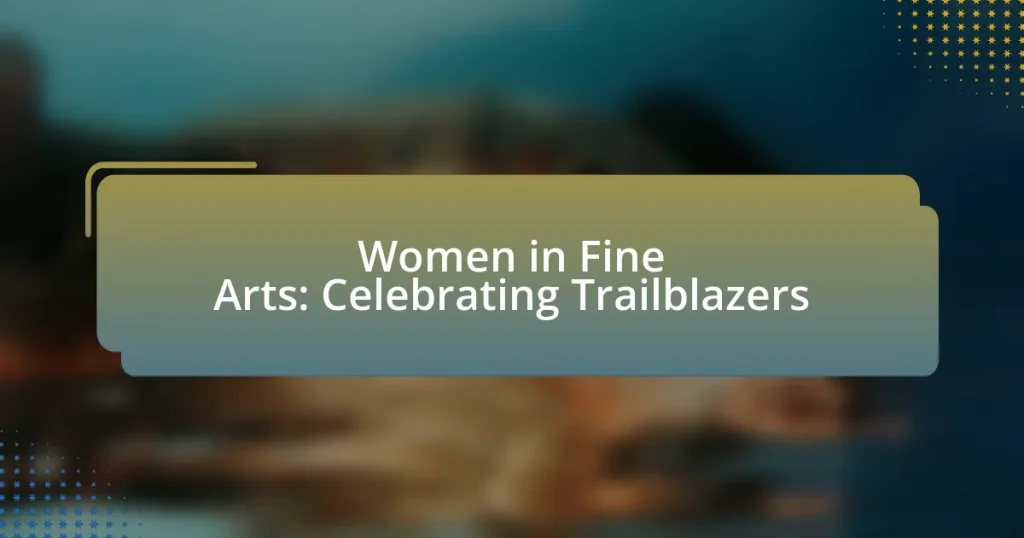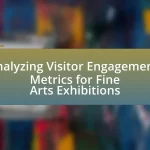The article “Women in Fine Arts: Celebrating Trailblazers” examines the significant contributions of women artists throughout history and their impact on the evolution of fine arts. It highlights the challenges women have faced, including historical barriers to education and professional opportunities, and discusses how their roles have transformed over time. Notable figures such as Georgia O’Keeffe and Frida Kahlo are featured for their pioneering work and influence on contemporary art and feminism. The article also emphasizes the importance of recognizing and supporting female artists today through initiatives, mentorship, and advocacy to promote gender equity in the art world.
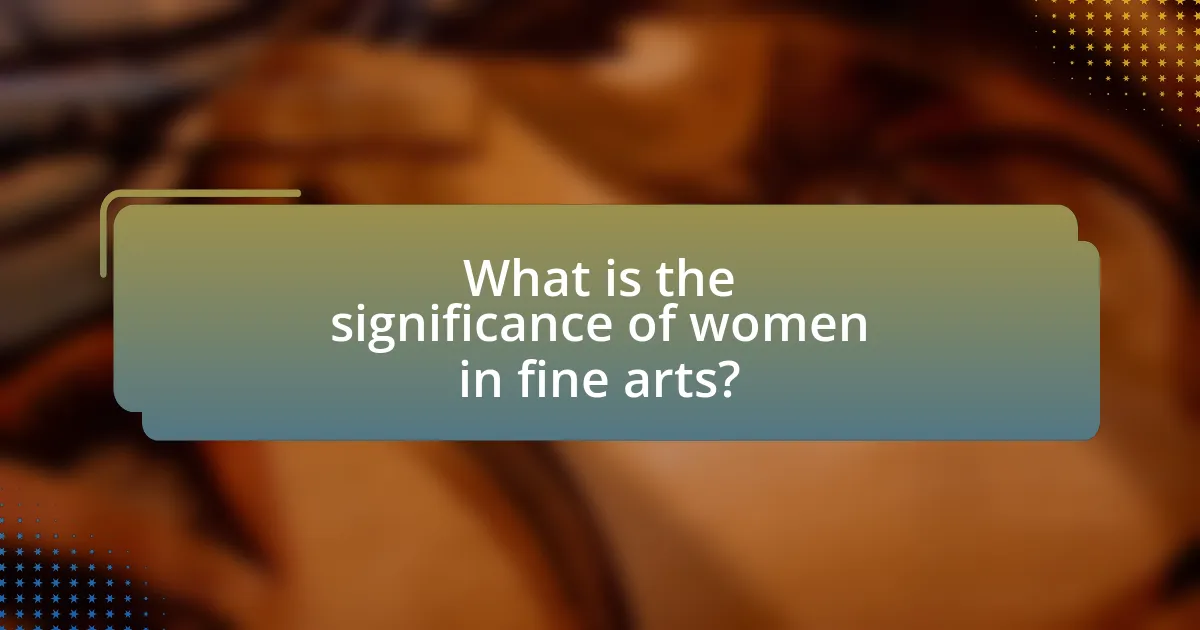
What is the significance of women in fine arts?
Women play a crucial role in fine arts by contributing unique perspectives and challenging traditional narratives. Historically, women artists have often been marginalized, yet their work has significantly influenced various art movements, such as the feminist art movement in the 1970s, which aimed to address gender inequality in the art world. Notable figures like Georgia O’Keeffe and Frida Kahlo have not only gained recognition for their innovative styles but have also inspired future generations of female artists. Their contributions highlight the importance of diversity in artistic expression and the need for inclusive representation in the arts.
How have women contributed to the evolution of fine arts?
Women have significantly contributed to the evolution of fine arts by breaking barriers and introducing diverse perspectives and techniques. Historically, artists like Artemisia Gentileschi in the 17th century challenged gender norms through powerful depictions of women in her paintings, influencing the Baroque style. In the 20th century, figures such as Georgia O’Keeffe and Frida Kahlo expanded the boundaries of modern art, with O’Keeffe’s abstract landscapes and Kahlo’s introspective self-portraits reflecting personal and cultural identity. Additionally, the feminist art movement of the 1970s, led by artists like Judy Chicago and Miriam Schapiro, sought to address gender inequality in the art world, paving the way for future generations of female artists. These contributions have not only enriched the fine arts but have also reshaped the narrative around women’s roles in artistic expression.
What historical barriers did women face in the fine arts?
Women faced significant historical barriers in the fine arts, including limited access to formal education, societal expectations, and exclusion from professional networks. For instance, art academies often denied women admission or restricted their training to specific subjects deemed appropriate, such as still life or portraiture, rather than allowing them to study the male-dominated fields like history painting. Additionally, prevailing gender norms discouraged women from pursuing careers as professional artists, leading to a lack of representation in galleries and exhibitions. This systemic discrimination is evidenced by the fact that, in the 19th century, only a small percentage of women were able to gain recognition, with many resorting to using male pseudonyms to have their work acknowledged.
How have women’s roles in fine arts changed over time?
Women’s roles in fine arts have evolved significantly from being largely restricted to domestic and decorative arts to gaining recognition as professional artists and influential figures in the art world. Historically, women were often excluded from formal art education and professional opportunities, limiting their contributions to the arts. However, the late 19th and early 20th centuries saw a shift as movements like Impressionism and the suffrage movement encouraged women to pursue artistic careers. Notable figures such as Georgia O’Keeffe and Frida Kahlo emerged, challenging societal norms and gaining prominence. By the late 20th century, women’s contributions were increasingly acknowledged, leading to greater representation in galleries and museums, as evidenced by the inclusion of female artists in major exhibitions and collections. This transformation reflects broader societal changes regarding gender equality and the recognition of women’s creative talents.
Why is it important to celebrate women trailblazers in fine arts?
Celebrating women trailblazers in fine arts is important because it acknowledges their significant contributions and challenges the historical gender biases in the field. Women artists have often been marginalized, yet figures like Georgia O’Keeffe and Frida Kahlo have reshaped artistic narratives and inspired future generations. Recognizing their achievements not only promotes gender equality but also enriches the cultural landscape by diversifying perspectives and narratives within the arts. Studies show that diverse representation in the arts leads to greater innovation and creativity, highlighting the necessity of celebrating these trailblazers.
What impact do female artists have on contemporary art?
Female artists significantly influence contemporary art by introducing diverse perspectives and challenging traditional narratives. Their contributions have led to a broader representation of gender, race, and identity within the art world. For instance, artists like Yayoi Kusama and Cindy Sherman have utilized their work to explore themes of mental health and identity, reshaping the discourse around these subjects. Additionally, the rise of feminist art movements has prompted institutions to reevaluate their collections and exhibitions, resulting in increased visibility for women artists. According to the National Museum of Women in the Arts, only 11% of artists in major museums are women, highlighting the ongoing need for equity and representation. This data underscores the critical role female artists play in advocating for change and expanding the boundaries of contemporary art.
How does recognition of women in fine arts influence future generations?
Recognition of women in fine arts significantly influences future generations by providing role models and validating the contributions of female artists. This acknowledgment encourages young women to pursue careers in the arts, fostering a more inclusive and diverse creative landscape. Historical data shows that when women artists are celebrated, such as through exhibitions and awards, it leads to increased visibility and opportunities for emerging female artists. For instance, the National Museum of Women in the Arts reports that exhibitions featuring women artists can inspire up to 70% of young female attendees to consider careers in the arts, demonstrating the direct impact of recognition on future generations.
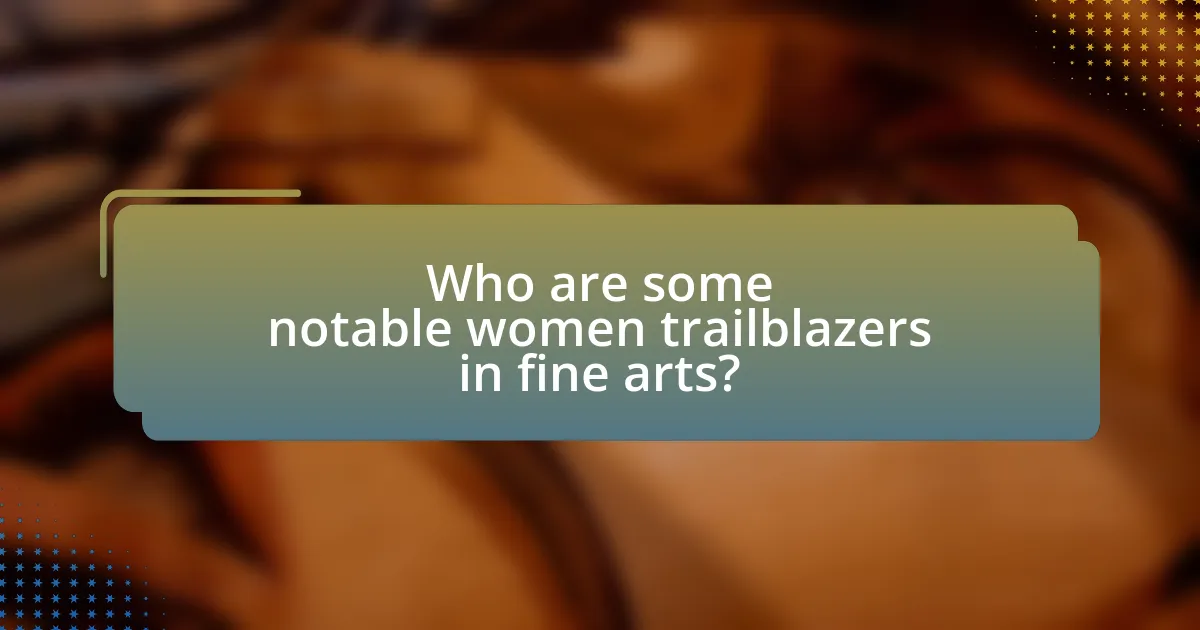
Who are some notable women trailblazers in fine arts?
Notable women trailblazers in fine arts include Georgia O’Keeffe, known for her large-scale flower paintings and desert landscapes, and Frida Kahlo, recognized for her deeply personal and symbolic self-portraits. Additionally, Louise Bourgeois made significant contributions to sculpture and installation art, while Cindy Sherman is celebrated for her conceptual photography that explores identity and representation. These artists have not only shaped the fine arts landscape but also paved the way for future generations of women in the field.
What are the contributions of specific women artists throughout history?
Women artists have made significant contributions throughout history, shaping the landscape of fine arts across various movements and styles. For instance, Artemisia Gentileschi, a Baroque painter, is renowned for her powerful depictions of women from biblical and mythological narratives, challenging the male-dominated art world of the 17th century. Georgia O’Keeffe, a pivotal figure in American modernism, is celebrated for her large-scale flower paintings and desert landscapes, which emphasized abstraction and the beauty of nature. Frida Kahlo, known for her deeply personal and symbolic self-portraits, explored themes of identity, postcolonialism, and gender, influencing feminist art movements. Additionally, Yayoi Kusama’s avant-garde installations and polka dot motifs have made her a key figure in contemporary art, addressing issues of mental health and infinity. These artists, among many others, have not only contributed unique perspectives and styles but have also paved the way for future generations of women in the arts.
How did Frida Kahlo influence modern art and feminism?
Frida Kahlo significantly influenced modern art and feminism through her unique self-portraits and exploration of identity, pain, and gender. Her artwork often depicted her personal struggles, including physical suffering and emotional turmoil, which resonated with many and challenged traditional representations of women in art. Kahlo’s bold use of color and symbolism, combined with her unapologetic expression of her experiences as a woman, positioned her as a pioneer in feminist art. Her work inspired subsequent generations of female artists to explore their own identities and experiences, contributing to the feminist movement by emphasizing the importance of personal narrative in art. Kahlo’s legacy is evident in the way contemporary artists continue to address themes of gender, identity, and the female experience, solidifying her role as a crucial figure in both modern art and feminist discourse.
What legacy did Georgia O’Keeffe leave in the art world?
Georgia O’Keeffe left a transformative legacy in the art world by pioneering modernist painting and elevating the status of women artists. Her distinctive style, characterized by large-scale flowers, landscapes, and abstract forms, challenged traditional representations and emphasized the beauty of the natural world. O’Keeffe’s work not only gained critical acclaim but also inspired future generations of artists, particularly women, to explore their unique perspectives and assert their voices in a male-dominated field. Her exhibitions, including the landmark retrospective at the Museum of Modern Art in 1946, solidified her influence and established her as a key figure in American art history.
What challenges did these women overcome to achieve success?
Women in fine arts overcame significant challenges such as gender discrimination, lack of access to education and resources, and societal expectations that limited their opportunities. For instance, many female artists faced barriers in gaining recognition and support in a male-dominated field, which often undervalued their contributions. Historical data shows that women artists were frequently excluded from prestigious exhibitions and institutions, making it difficult for them to establish their careers. Additionally, balancing familial responsibilities with professional aspirations posed a substantial challenge, as societal norms often dictated that women prioritize home life over their artistic pursuits. These obstacles highlight the resilience and determination of women in fine arts who navigated these adversities to achieve success and recognition in their field.
How did societal expectations shape their artistic expressions?
Societal expectations significantly shaped women’s artistic expressions by imposing limitations on their subject matter, style, and professional opportunities. Historically, women artists were often expected to focus on domestic themes and traditional genres, such as still life and portraiture, rather than more avant-garde or politically charged subjects. For instance, during the 19th century, women like Mary Cassatt and Berthe Morisot navigated these constraints by depicting intimate domestic scenes, which aligned with societal views of women’s roles. Additionally, societal norms restricted women’s access to formal training and exhibition opportunities, compelling many to adopt pseudonyms or work within the confines of male-dominated art institutions. This context illustrates how societal expectations not only influenced the content of women’s art but also dictated their paths to recognition and success in the fine arts.
What role did mentorship play in their careers?
Mentorship played a crucial role in the careers of women in fine arts by providing guidance, support, and networking opportunities that facilitated their professional growth. Many trailblazing women artists, such as Georgia O’Keeffe and Judy Chicago, benefited from mentorship relationships that helped them navigate the male-dominated art world. For instance, O’Keeffe was mentored by Alfred Stieglitz, who not only promoted her work but also provided her with critical feedback that shaped her artistic vision. This mentorship not only enhanced their skills but also increased their visibility and credibility in the art community, ultimately leading to greater recognition and success in their careers.
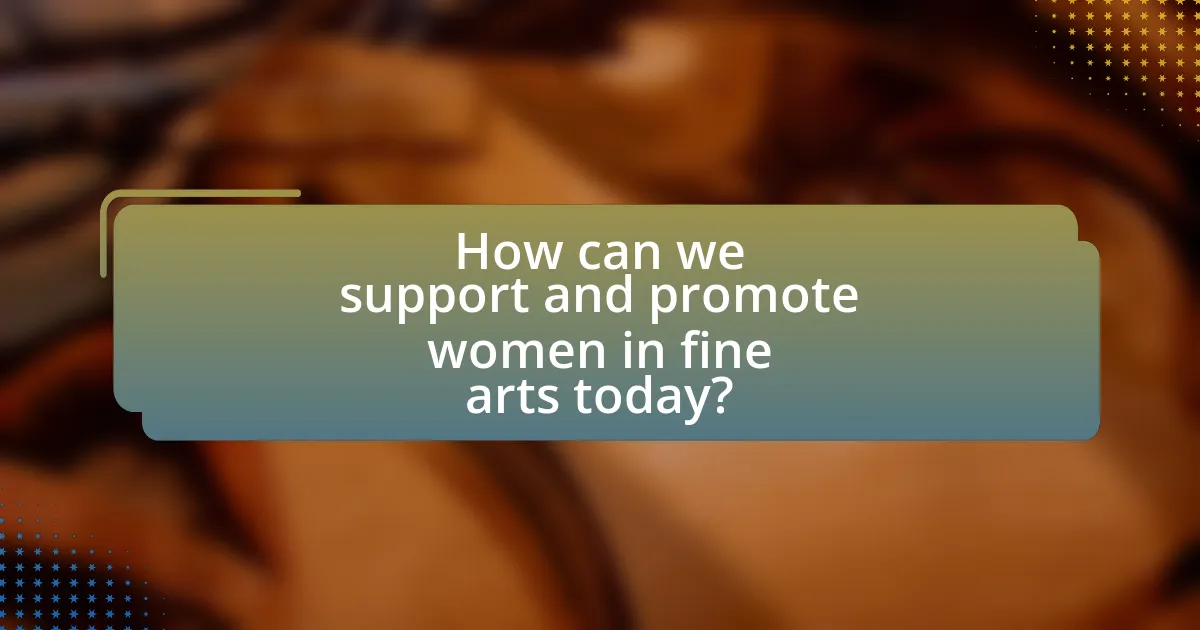
How can we support and promote women in fine arts today?
To support and promote women in fine arts today, institutions and organizations should implement targeted funding initiatives and mentorship programs specifically designed for female artists. Research indicates that women artists receive significantly less funding and exhibition opportunities compared to their male counterparts; for instance, a 2020 study by the National Endowment for the Arts found that only 30% of solo exhibitions in major galleries featured women artists. By establishing grants and scholarships aimed at women, as well as creating platforms for their work to be showcased, the art community can help bridge this gap. Additionally, promoting female-led art collectives and ensuring representation in art fairs and exhibitions can further elevate women’s visibility in the fine arts sector.
What initiatives exist to empower women artists in the fine arts community?
Initiatives that empower women artists in the fine arts community include organizations like the National Museum of Women in the Arts, which promotes women’s contributions to the arts through exhibitions, educational programs, and advocacy. Additionally, the Women’s Caucus for Art provides networking opportunities, mentorship, and resources specifically aimed at supporting women artists. Programs such as the Artadia Awards and the Elizabeth Foundation for the Arts also focus on providing grants and fellowships to women artists, enhancing their visibility and financial stability in the art world. These initiatives collectively aim to address gender disparities and foster a more inclusive environment for women in the fine arts.
How do art institutions support female artists through exhibitions and grants?
Art institutions support female artists through exhibitions and grants by providing platforms that showcase their work and financial resources that enable their artistic development. For instance, many galleries and museums curate exhibitions specifically highlighting female artists, such as the “Women Artists: 1550-1950” exhibition at the National Museum of Women in the Arts, which aimed to increase visibility for women in the art world. Additionally, organizations like the Elizabeth Foundation for the Arts offer grants specifically for female artists, helping them fund projects and gain recognition. These initiatives are crucial in addressing historical gender disparities in the art sector, as studies show that female artists receive significantly less exhibition space and funding compared to their male counterparts.
What role do art collectives play in promoting women artists?
Art collectives play a crucial role in promoting women artists by providing a collaborative platform that amplifies their visibility and fosters community support. These collectives often organize exhibitions, workshops, and events specifically highlighting the work of women artists, which helps to counteract the historical underrepresentation of women in the art world. For instance, collectives like the Guerrilla Girls and Women’s Caucus for Art have been instrumental in advocating for gender equity in art institutions and creating opportunities for women artists to showcase their work. This collective action not only raises awareness about the challenges faced by women artists but also encourages dialogue and collaboration among artists, ultimately leading to greater recognition and opportunities in the art market.
What can individuals do to advocate for women in fine arts?
Individuals can advocate for women in fine arts by actively promoting and supporting female artists through various means. This includes attending exhibitions featuring women artists, purchasing their work, and sharing their art on social media platforms to increase visibility. Research indicates that women artists receive significantly less representation in galleries and museums; for instance, a 2019 study by the National Museum of Women in the Arts found that only 11% of artists in major U.S. museums are women. By amplifying the voices and works of female artists, individuals can help address this disparity and foster a more inclusive art community.
How can art enthusiasts contribute to the visibility of women artists?
Art enthusiasts can contribute to the visibility of women artists by actively promoting their work through social media, attending exhibitions, and supporting women-led galleries. By sharing artworks and stories of women artists online, enthusiasts can reach wider audiences and raise awareness about their contributions to the art world. Statistics show that women artists are often underrepresented in galleries and exhibitions; for instance, a 2020 report by the National Museum of Women in the Arts found that only 11% of artists in major U.S. museums are women. Therefore, by advocating for equal representation and visibility, art enthusiasts play a crucial role in changing this narrative.
What are effective ways to engage with and support female artists’ work?
Effective ways to engage with and support female artists’ work include promoting their art through exhibitions, providing funding opportunities, and creating mentorship programs. Exhibitions that feature female artists can increase visibility and appreciation for their work, as evidenced by the success of initiatives like the “Women in the Arts” exhibitions, which have shown significant attendance and sales. Funding opportunities, such as grants specifically for female artists, can alleviate financial barriers, as studies indicate that women artists often receive less funding than their male counterparts. Additionally, mentorship programs that connect emerging female artists with established professionals can foster growth and development, as research shows that mentorship significantly enhances career advancement for women in the arts.










